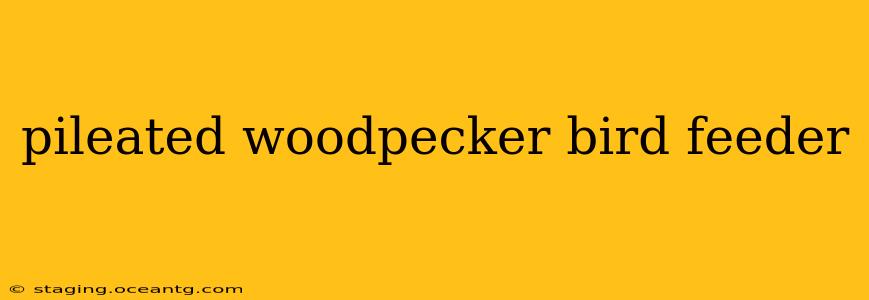The pileated woodpecker, with its striking red crest and impressive size, is a captivating sight in any backyard. However, attracting these magnificent birds to your feeder requires a bit more than simply hanging up a standard seed feeder. Their powerful beaks and preference for insects and specific types of wood make attracting them a rewarding challenge. This guide delves into the best strategies for luring these charismatic woodpeckers to your yard.
What kind of bird feeder attracts pileated woodpeckers?
Pileated woodpeckers aren't your typical seed-eating birds. They primarily feed on insects, which they excavate from trees, and occasionally on nuts and fruits. While they may occasionally visit a suet feeder, a standard seed feeder is unlikely to attract them. Instead, focus on feeders that offer suet, nuts, or fruit. A sturdy platform feeder or a suet feeder with a strong, wide perch is ideal. The feeder needs to be able to withstand their powerful pecking.
What food do pileated woodpeckers eat?
Pileated woodpeckers have a diverse diet. Their primary food source is insects, particularly carpenter ants, which they find by excavating decaying wood. They also consume a variety of other insects, larvae, and grubs. Supplementarily, they'll eat nuts, seeds, berries, and fruits. Understanding this varied diet is key to attracting them.
Do pileated woodpeckers eat suet?
Yes, pileated woodpeckers will eat suet, although it's not their primary food source. Suet is a high-energy food, offering them a quick and easy source of calories. Offering suet cakes, especially those with added nuts or fruit, can be an effective way to attract them to your yard, particularly during colder months. Remember to choose a sturdy suet feeder that can withstand their powerful pecking.
How do I attract pileated woodpeckers to my yard?
Attracting pileated woodpeckers goes beyond simply providing food. These birds require specific habitat features to feel comfortable and safe.
- Provide a reliable food source: As mentioned, offer suet, nuts (especially peanuts), and fruit. Consider adding a variety to keep them interested.
- Ensure a water source: A bird bath or other water source is essential for all birds, including pileated woodpeckers. Make sure the water is fresh and clean.
- Offer suitable habitat: Pileated woodpeckers require large trees for foraging and nesting. If you have mature trees, excellent! If not, planting trees is a long-term strategy to attract them. They also appreciate dead or decaying wood, as this is where they find many of their insect prey. Leaving some dead wood in your yard can be beneficial.
- Location, Location, Location: Place your feeder in a relatively open area where they can easily see potential predators and have a clear flight path. Avoid placing it too close to dense vegetation.
- Be Patient: Attracting pileated woodpeckers takes time and consistency. They are not easily lured. Continue offering food and providing habitat features, and eventually, you may be rewarded with their presence.
What type of suet do pileated woodpeckers like?
While there's no definitive "favorite" suet, those with added nuts, seeds, and fruits are more likely to attract pileated woodpeckers due to their diverse diet. Consider suet blends specifically formulated for woodpeckers.
Will pileated woodpeckers damage my house?
While pileated woodpeckers may drum on trees and occasionally on wooden structures, this is generally not a cause for concern unless there is already significant wood damage present. Healthy wood is usually too solid for them to penetrate. However, if you have damaged or decaying wood on your home's exterior, they might be attracted to it. Addressing any existing damage is crucial.
By understanding their dietary needs and habitat preferences, and by consistently providing a suitable environment, you'll greatly increase your chances of attracting these remarkable birds to your yard and experiencing the thrill of watching these magnificent creatures up close. Remember, patience is key, and consistent efforts will eventually pay off.
